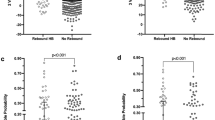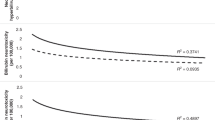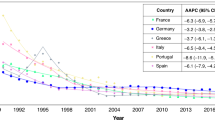Abstract
Background
Maternal exposure to pesticides during pregnancy may cause oxidative hemolysis leading to neonatal hyperbilirubinemia. This investigation examined for associations between maternal use of pesticides or repellents during pregnancy and neonatal hyperbilirubinemia requiring phototherapy.
Methods
We used the dataset from the Japan Environment and Children’s Study, a large national birth cohort study registered from January 31, 2011 to March 31, 2014. The fixed data of 61,751 live births were used to evaluate the presence of neonatal hyperbilirubinemia and potential confounding factors. We employed multiple logistic regression analysis to identify correlations between the frequency of maternal pesticide or repellent use during pregnancy and clinically relevant neonatal hyperbilirubinemia.
Results
After controlling for confounding factors, there were significant associations between neonatal hyperbilirubinemia necessitating phototherapy and the frequent use of indoor insecticide spray (OR 1.21, 95% CI 1.05–1.38). For spray- or lotion-type insect repellents, an opposite relationship was observed (more than a few times a week: OR 0.70, 95% CI 0.61–0.81, up to a few times a month: OR 0.84, 95% CI 0.78–0.91).
Conclusion
The frequent use of indoor insecticide spray during pregnancy showed an increased risk of neonatal hyperbilirubinemia requiring phototherapy, which was absent for spray- or lotion-type insect repellents.
Impact
-
The frequent use of indoor insecticide spray during pregnancy showed an increased risk of neonatal hyperbilirubinemia requiring phototherapy, which was absent for spray- or lotion-type insect repellents.
-
This is the first study examining the effects of maternal exposure to pesticides or repellents on clinically relevant neonatal hyperbilirubinemia using a dataset from a nationwide birth cohort study.
-
This large-scale Japanese cohort study revealed that the frequent use of indoor insecticide spray during pregnancy may increase the risk of neonatal hyperbilirubinemia requiring treatment.
Similar content being viewed by others
Log in or create a free account to read this content
Gain free access to this article, as well as selected content from this journal and more on nature.com
or
References
Porter, M. L. & Dennis, B. L. Hyperbilirubinemia in the term newborn. Am. Fam. Physician 65, 599–606 (2002).
Neuman, T. B., Easterling, M. J., Goldman, E. S. & Stevenson, D. K. Laboratory evaluation of jaundice in newborns. Frequency, cost, and yield. Am. J. Dis. Child 144, 364–368 (1990).
Maruo, Y., Nishizawa, K., Sato, H., Doida, Y. & Shimada, M. Association of neonatal hyperbilirubinemia with bilirubin UDP-glucuronosyltransferase polymorphism. Pediatrics 103, 1224–1227 (1999).
Gopinathan, V., Miller, N. J., Milner, A. D. & Rice-Evans, C. A. Bilirubin and ascorbate antioxidant activity in neonatal plasma. FEBS Lett. 349, 197–200 (1994).
Dennery, P. A., Seidman, D. S. & Stevenson, D. K. Neonatal hyperbilirubinemia. N. Engl. J. Med. 344, 581–590 (2001).
Maisels, M. J. & McDonagh, A. F. Phototherapy for neonatal jaundice. N. Engl. J. Med. 358, 920–928 (2008).
Ojha, A. & Gupta, Y. K. Study of commonly used organophosphate pesticides that induced oxidative stress and apoptosis in peripheral blood lymphocytes of rats. Hum. Exp. Toxicol. 36, 1158–1168 (2017).
López, O. et al. Changes in antioxidant enzymes in humans with long-term exposure to pesticides. Toxicol. Lett. 171, 146–153 (2007).
El-Bini Dhoib, I., Lasram, M. M., Annabi, A., Gharbi, N. & El-Fazaa, S. A comparative study on toxicity induced by carbosulfan and malathion in Wister rat liver and spleen. Pestic. Biochem. Physiol. 124, 21–28 (2015).
Bal, R. et al. Effects of clothianidin exposure on sperm quality, testicular apoptosis and fatty acid composition in developing male rats. Cell Biol. Toxicol. 28, 187–200 (2012).
Deeba, F. et al. Chlorpyrifos and lambda cyhalothrin-induced oxidative stress in human erythrocytes. Toxicol. Ind. Health 33, 297–307 (2017).
Abu-Qure, A. W., Suliman, H. B. & Abou-Donia, M. B. Induction of urinary excretion of 3-nitorothyrosine, a marker of oxidative stress, following administration of pyridostigmine bromide, DEET (N,N-diethyl-m-toluamide) and permethrin, alone and in combination in rats. Toxicol. Lett. 121, 127–134 (2001).
Ambali, S. F., Ayo, J. O., Ojo, S. A. & Esievo, K. A. N. Vitamin E protects Wister rats from chlorpyrifos-induced increase in erythrocyte osmotic fragility. Food Chem. Toxicol. 48, 3477–3480 (2010).
Quintana, M. M., Vera, B., Magnarelli, G., Guiñazú, N. & Rovedatti, M. G. Neonatal, placental, and umbilical cord blood parameters in pregnant women residing in areas with intensive pesticide application. Environ. Sci. Pollut. Res. 24, 20736–20746 (2017).
Kawamoto, T. et al. Working Group of the Epidemiological Research for Children’s Environmental Health. Rationale and study design of the Japan environment and children’s study (JECS). BMC Public Health 14, 25 (2014).
Imura, S. Phototherapy of neonatal jaundice: its indication and prevention of adverse effects. Nihon Rinsho 43, 1741–1748 (1985).
Nakamura, H., Yonetani, M., Uetani, Y., Funato, M. & Lee, Y. Determination of serum unbound bilirubin for prediction of kernicterus in low birthweight infants. Acta Pediatr. Jpn 34, 642–647 (1992).
U.S. Department of Agriculture. Pesticide Data Program Annual Summary, Calendar Year 2006 (U.S. Department of Agriculture, 2007).
Sutton, P., Perron, J., Giudice, L. C. & Woodruff, T. J. Pesticides Matter. A Primer for Reproductive Health Physicians (University of California, San Francisco, Program on Reproductive Health and the Environment, 2011).
Naeher, L. P. et al. Organophospholus and pyrethroid insecticide urinary metabolite concentrations in young children living in a southeastern United States city. Sci. Total Environ. 408, 1145–1153 (2010).
Morgan, M. K. et al. An observational study of 127 preschool children at their homes and daycare centers in Ohio: environmental pathways to cis-and trans-permethrin exposure. Environ. Res. 104, 266–274 (2007).
Starr, J., Graham, S., Stout, D. 2nd, Andrews, K. & Nishioka, M. Pyrethroid pesticides and their metabolites in vacuum cleaner dust collected from homes and day-care centers. Environ. Res. 108, 271–279 (2008).
Whyatt, R. M. et al. Prenatal insecticide exposures and birth weight and length among an urban minority cohort. Environ. Health Perspect. 112, 1125–1132 (2004).
Barr, D. B. et al. Pesticide concentrations in maternal and umbilical cord sera and their relation to birth outcomes in a population of pregnant women and newborns in New Jersey. Sci. Total Environ. 408, 790–795 (2010).
Rauh, V. et al. Seven-year neurodevelopmental scores and prenatal exposure to chlorpyrifos, a common agricultural pesticide. Environ. Health Perspect. 119, 1196–1201 (2011).
Brender, J. D., Felkner, M., Suarez, L., Canfield, M. A. & Henry, J. P. Maternal pesticide exposure and neural tube defects in Mexican Americans. Ann. Epidemiol. 20, 16–22 (2010).
Garry, V. F., Schreinemachers, D., Harkins, M. E. & Griffith, J. Pesticide appliers, biocides, and birth defects in rural Minnesota. Environ. Health Perspect. 104, 394–399 (1996).
Muñoz-Quezada, M. T. et al. Neurodevelopmental effects in children associated with exposure to organophosphate pesticides: a systematic review. Neurotoxicology 39, 158–168 (2013).
Tian, J. N. & Yiin, L. M. Urinary metabolites of DEET after dermal application on child and adult subjects. J. Environ. Health 76, 162–169 (2014).
McGready, R. et al. Safety of the insect repellent N,N-Diethil-M-Toluamide (DEET) in pregnancy. Am. J. Trop. Med. Hyg. 65, 285–289 (2001).
Morioka, I. et al. Current management and treatment for neonatal jaundice in extremely preterm infants in Japan, Japan Neonatal Jaundice Study Group, Japan. J. Jpn. Soc. Neonatal Health Dev. 27, 299–304 (2015).
Japan Environment and Children’s Study (JECS) Protocol (ver.1.4). http://www.env.go.jp/chemi/ceh/en/about/advanced/material/jecs-study_protocol_14_en.pdf(2016).
Acknowledgements
This research was supported by The Japan Environment and Children’s Study (JECS) Group. We sincerely thank all the participants in this study and all individuals involved in data collection. The Japan Environment and Children’s Study was funded by the Ministry of the Environment of the Government of Japan. The finding and conclusions of this study are solely the response of the authors and do not represent the official views of the above government.
the Japan Environment & Children’s Study (JECS) Group
Toshihiro Kawamoto6, Hirohisa Saito7, Reiko Kishi8, Nobuo Yaegashi9, Koichi Hashimoto10, Chisato Mori11, Shuichi Ito12, Zentaro Yamagata13, Hidekuni Inadera14, Michihiro Kamijima15, Takeo Nakayama16, Hiroyasu Iso17, Masayuki Shima18, Yasuaki Hirooka19, Narufumi Suganuma20, Koichi Kusuhara6 and Takahiko Katoh21
Author information
Authors and Affiliations
Consortia
Contributions
T.S., N.M., and T.N. designed the study. Y.M. and S.O. contributed to data collection. T.S. and T.N. performed statistical analysis and interpretation of data. T.S. drafted the article. N.M., Y.I., M.K., H.K., Y.N., T.T, T.N. and members of the Japan Environment & Children’s Study (JECS) Group revised the manuscript critically for important intellectual content. All members reviewed and approved the manuscript.
Corresponding author
Ethics declarations
Competing interests
The authors declare no competing interests.
Patient consent
Written informed consent was obtained from each participant.
Additional information
Publisher’s note Springer Nature remains neutral with regard to jurisdictional claims in published maps and institutional affiliations.
Supplementary information
Rights and permissions
About this article
Cite this article
Shibazaki, T., Motoki, N., Misawa, Y. et al. Association between pesticide usage during pregnancy and neonatal hyperbilirubinemia requiring treatment: the Japan Environment and Children’s Study. Pediatr Res 89, 1565–1570 (2021). https://doi.org/10.1038/s41390-020-1100-6
Received:
Revised:
Accepted:
Published:
Issue date:
DOI: https://doi.org/10.1038/s41390-020-1100-6



